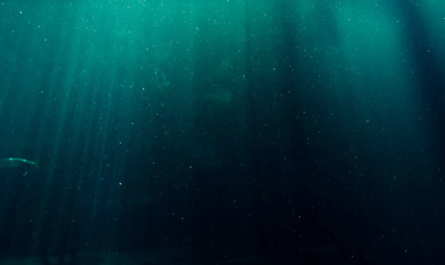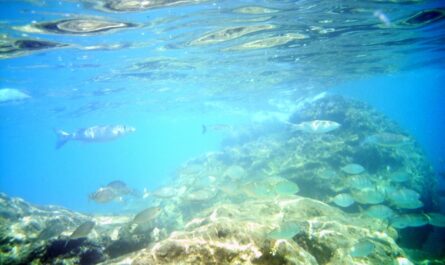Deep beneath the surface of the Atlantic Ocean lies a hidden world teeming with life—a realm where extreme conditions and extraordinary chemistry give birth to ecosystems unlike any on the surface. Hydrothermal vents, often referred to as deep-sea oases, are underwater hot springs found primarily along mid-ocean ridges and tectonic plate boundaries. These vents, with their superheated, mineral-rich fluids, create unique habitats that challenge our understanding of life and offer clues to the origins of life on Earth. In this comprehensive exploration, we delve into the science behind hydrothermal vents, the ecosystems they support, the technological advancements that allow us to study these remote environments, and their significance for both our planet and the future of biological research.
1. What Are Hydrothermal Vents?
The Basics of Hydrothermal Vent Formation
Hydrothermal vents are formed when seawater seeps into the ocean floor through cracks and fissures near tectonic plate boundaries. As this water travels downward, it is heated by the underlying magma and, in the process, becomes enriched with dissolved minerals such as sulfur, iron, and manganese. When the superheated, mineral-laden water is expelled back into the cold ocean, it creates a dramatic contrast in temperature and chemistry, leading to the formation of mineral deposits around the vent. These deposits, often referred to as “black smokers” or “white smokers” depending on their appearance, create the physical structures of the vent systems.
Types of Hydrothermal Vents
Hydrothermal vents come in several forms:
- Black Smokers: These vents emit dark, mineral-rich water that precipitates into sulfide minerals, forming towering chimneys.
- White Smokers: These emit lighter-colored, silica-rich fluids that create different mineral deposits and structures.
- Diffuse Flow Vents: These are areas where venting is less intense, providing a more moderate environment that supports a diverse range of organisms.
2. The Unique Ecosystems of Hydrothermal Vents
Life in Extreme Conditions
Despite the seemingly inhospitable conditions—high pressure, extreme temperatures, and complete darkness—hydrothermal vents are home to thriving communities of organisms. The key to this biological success lies in chemosynthesis, a process by which certain bacteria convert the chemicals emitted by the vents into energy. Unlike photosynthesis, which depends on sunlight, chemosynthesis relies on the oxidation of chemicals like hydrogen sulfide to fuel the production of organic molecules. This process forms the base of the vent food chain, supporting a diverse array of life.
Species Adaptations and Biodiversity
Hydrothermal vent communities are characterized by their incredible biodiversity and unique adaptations:
- Tube Worms: Giant tube worms, such as Riftia pachyptila, can grow several feet long and house symbiotic bacteria in their tissues. These bacteria produce nutrients through chemosynthesis, providing sustenance for the worms.
- Vent Crabs and Shrimp: These species have evolved specialized feeding habits and behaviors that allow them to thrive in the nutrient-rich environment of the vents.
- Unique Mollusks and Fish: Many vent-dwelling mollusks and fish exhibit adaptations like reduced eyes or bioluminescence, traits that help them survive in the perpetual darkness of the deep ocean.
- Microbial Diversity: At the heart of these ecosystems are diverse microbial communities that drive the chemosynthetic processes essential for the vent ecosystem’s productivity.
The remarkable resilience of these organisms challenges our conventional understanding of life’s requirements, demonstrating that life can flourish under conditions previously thought to be too extreme.
3. The Scientific Significance of Hydrothermal Vents
Clues to the Origins of Life
One of the most fascinating aspects of hydrothermal vents is their potential connection to the origins of life on Earth. Many scientists theorize that life may have begun near hydrothermal vents, where the combination of heat, minerals, and a stable environment could have provided the ideal conditions for the formation of complex organic molecules. The study of these vents, therefore, offers valuable insights into how life might have originated and evolved in the early oceans.
Advancements in Marine Biology and Biotechnology
The unique environments of hydrothermal vents have spurred numerous scientific discoveries:
- Novel Enzymes and Biochemicals: The extreme conditions at vents have led to the evolution of enzymes that function optimally at high temperatures and pressures. These enzymes have potential applications in industrial biotechnology, from chemical synthesis to biofuel production.
- New Species Discovery: Ongoing research continues to uncover previously unknown species and genetic adaptations that not only expand our understanding of biodiversity but also hold promise for biotechnological innovations.
- Insights into Climate Regulation: Hydrothermal vents play a role in the global carbon cycle by facilitating the sequestration of carbon in mineral deposits. Understanding these processes can help scientists better predict how the oceans will respond to climate change.
Technological Innovations in Deep-Sea Exploration
Studying hydrothermal vents in the deep Atlantic has been made possible by significant advancements in technology:
- Remotely Operated Vehicles (ROVs): These unmanned submersibles can dive to extreme depths, capturing high-definition footage and collecting samples from vent sites.
- Autonomous Underwater Vehicles (AUVs): AUVs are used for extensive mapping of the ocean floor, allowing researchers to identify vent locations and monitor changes over time.
- Advanced Sensors and Monitoring Equipment: Modern instruments can measure temperature, chemical composition, and other environmental variables in real time, providing detailed data on vent activity.
These technological advancements not only enhance our scientific understanding of hydrothermal vents but also contribute to broader marine conservation efforts.
4. Conservation Challenges and Environmental Impact
Threats to Hydrothermal Vent Ecosystems
Despite their remote locations, hydrothermal vent ecosystems face several threats:
- Deep-Sea Mining: The potential for mining valuable minerals from vent deposits poses a significant risk. Unregulated mining activities can disrupt these delicate ecosystems, leading to long-term ecological damage.
- Climate Change: Rising ocean temperatures and acidification can alter the delicate chemical balance that sustains vent ecosystems. These changes could impact the chemosynthetic processes that are the foundation of vent life.
- Pollution and Human Activity: Although less exposed to direct human impacts than coastal areas, deep-sea ecosystems are not immune to pollution. Runoff and waste from surface activities can eventually reach the deep ocean, affecting vent communities.
Conservation and Restoration Efforts
Efforts to protect hydrothermal vents are gaining momentum, driven by both scientific and environmental communities:
- Protected Marine Areas: Establishing marine protected areas (MPAs) around known vent sites can help shield these ecosystems from industrial activities.
- International Collaboration: The global nature of the oceans requires coordinated international policies to regulate activities that impact deep-sea environments. Collaborative research initiatives and agreements can play a crucial role in conservation.
- Sustainable Resource Management: Balancing the economic benefits of deep-sea mining with environmental protection is a complex challenge. Advocating for sustainable practices and rigorous environmental assessments is essential to ensure that vent ecosystems are preserved for future generations.
5. Future Directions in Hydrothermal Vent Research
Interdisciplinary Collaboration
The study of hydrothermal vents is inherently interdisciplinary, involving geology, marine biology, chemistry, and environmental science. Collaborative research efforts across these fields are crucial for advancing our understanding of vent ecosystems and developing strategies to protect them. Interdisciplinary projects not only lead to scientific breakthroughs but also foster innovation in conservation technologies.
Emerging Technologies
Future research on hydrothermal vents will likely benefit from further technological innovations:
- Improved Deep-Sea Robotics: As robotics continue to advance, the next generation of ROVs and AUVs will be able to operate more efficiently and for longer durations, capturing even more detailed data from vent environments.
- Enhanced Data Analytics: Big data and machine learning techniques can analyze the vast amounts of data collected from vent sites, helping researchers identify patterns, predict changes, and assess the health of these ecosystems.
- Bioengineering and Genetic Research: Advances in bioengineering may enable scientists to harness the unique properties of vent organisms, with potential applications in medicine, industry, and environmental remediation.
The Role of Citizen Science
Citizen science initiatives can also contribute to the study and conservation of hydrothermal vents. By involving the public in data collection and environmental monitoring, researchers can expand their reach and foster greater awareness about the importance of these deep-sea oases.
6. The Broader Impact of Hydrothermal Vents on Our Understanding of Life
A Window into Extreme Life
Hydrothermal vents challenge our traditional definitions of life. The organisms that inhabit these extreme environments thrive in conditions that would be lethal to most terrestrial life forms. Their survival strategies offer valuable insights into the adaptability of life, inspiring new theories about the potential for life on other planets and moons with similar harsh conditions.
Implications for the Search for Extraterrestrial Life
The study of hydrothermal vents is not limited to Earth-bound concerns. These deep-sea oases are often considered analogs for extraterrestrial environments—such as the subsurface oceans of Jupiter’s moon Europa or Saturn’s moon Enceladus. By understanding how life thrives around hydrothermal vents, scientists gain insights that could inform the search for life beyond our planet. The biochemical processes and genetic adaptations observed in vent organisms could serve as a blueprint for identifying life in similarly extreme conditions elsewhere in the universe.
Inspiring Innovation and Sustainable Practices
The sustainable nature of hydrothermal vent ecosystems, driven by natural processes such as chemosynthesis, serves as an inspiration for human innovation. Efforts to mimic these natural processes have led to advancements in biotechnology, renewable energy, and environmental conservation. The resilience and efficiency of vent ecosystems provide a model for developing sustainable practices that can benefit our own planet.
7. Conclusion: Embracing the Hidden Wonders of the Deep
The fascinating world of hydrothermal vents in the Atlantic reveals a realm of wonder and resilience hidden beneath the ocean’s surface. These deep-sea oases, formed by the dynamic interplay of geology and chemistry, support ecosystems that challenge our understanding of life and offer insights into the origins and potential future of life on Earth. From their role in shaping marine biodiversity to their implications for sustainable practices and extraterrestrial exploration, hydrothermal vents are at the forefront of scientific discovery and environmental innovation.
Despite the challenges posed by climate change, industrial activities, and pollution, the ongoing research and innovative restoration techniques provide hope for the preservation and recovery of these unique ecosystems. International collaboration, technological advancements, and dedicated conservation efforts are paving the way for a future where the Atlantic’s hydrothermal vents can continue to thrive and inspire.
As we deepen our understanding of these remarkable environments, we are reminded of the interconnectedness of Earth’s systems and the importance of protecting even the most remote corners of our planet. The study of hydrothermal vents not only enriches our knowledge of the natural world but also fuels our imagination, offering a glimpse into the incredible adaptability of life in the face of extreme challenges.
In a world where the impacts of climate change and human activity are increasingly felt, the hidden wonders of the deep serve as a powerful reminder of nature’s resilience. Embracing and protecting these deep-sea oases is not just a scientific imperative—it is a testament to our commitment to sustainable living and the preservation of our planet’s rich biodiversity for generations to come.
So, whether you are a researcher, a conservationist, or simply a curious explorer, the world of hydrothermal vents in the Atlantic invites you to dive into a realm of wonder, innovation, and hope—a reminder that even in the depths of the ocean, life finds a way to flourish.



